window Ram ProMaster 2014 Owner's Guide
[x] Cancel search | Manufacturer: RAM, Model Year: 2014, Model line: ProMaster, Model: Ram ProMaster 2014Pages: 410, PDF Size: 2.83 MB
Page 203 of 410
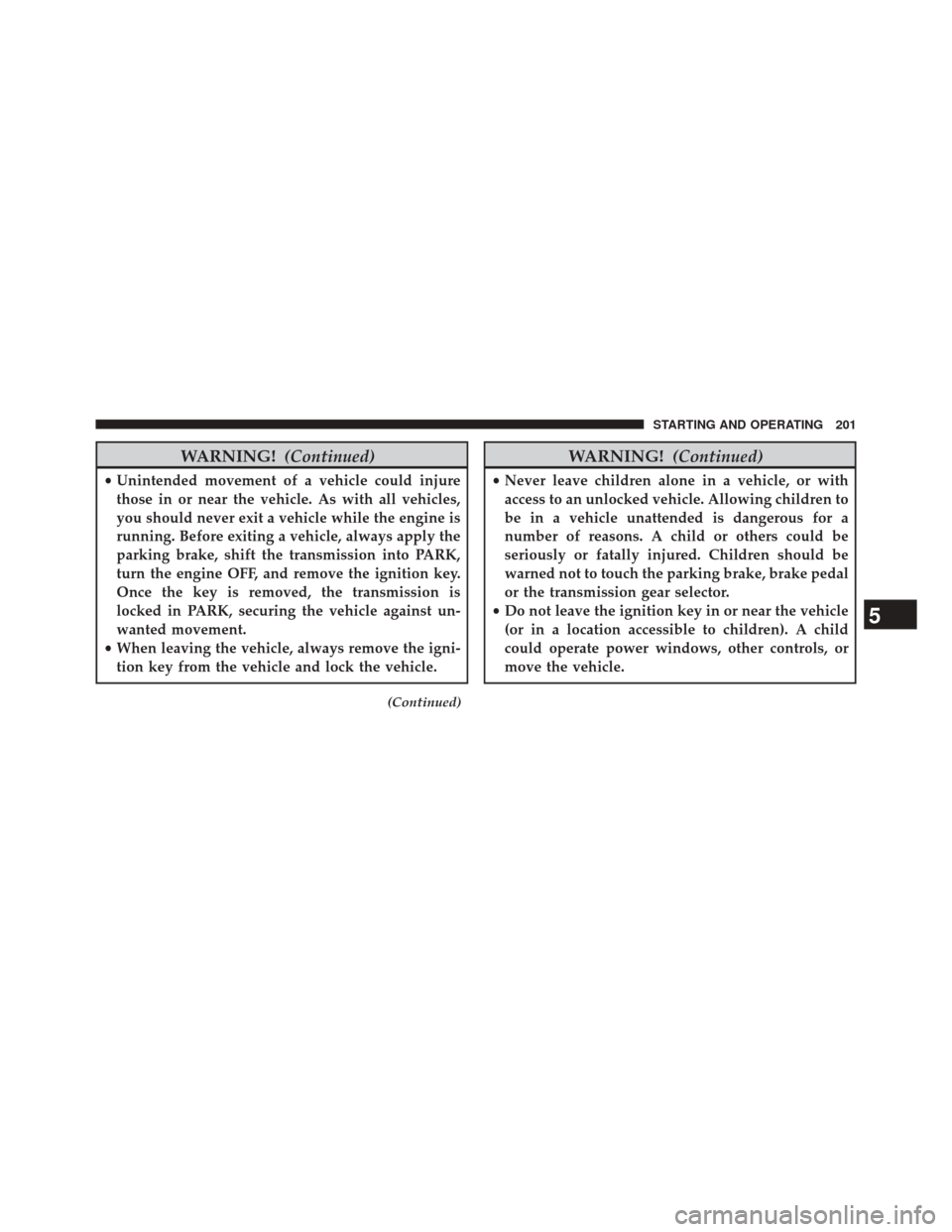
WARNING!(Continued)
•Unintended movement of a vehicle could injure
those in or near the vehicle. As with all vehicles,
you should never exit a vehicle while the engine is
running. Before exiting a vehicle, always apply the
parking brake, shift the transmission into PARK,
turn the engine OFF, and remove the ignition key.
Once the key is removed, the transmission is
locked in PARK, securing the vehicle against un-
wanted movement.
• When leaving the vehicle, always remove the igni-
tion key from the vehicle and lock the vehicle.
(Continued)
WARNING! (Continued)
•Never leave children alone in a vehicle, or with
access to an unlocked vehicle. Allowing children to
be in a vehicle unattended is dangerous for a
number of reasons. A child or others could be
seriously or fatally injured. Children should be
warned not to touch the parking brake, brake pedal
or the transmission gear selector.
• Do not leave the ignition key in or near the vehicle
(or in a location accessible to children). A child
could operate power windows, other controls, or
move the vehicle.
5
STARTING AND OPERATING 201
Page 216 of 410
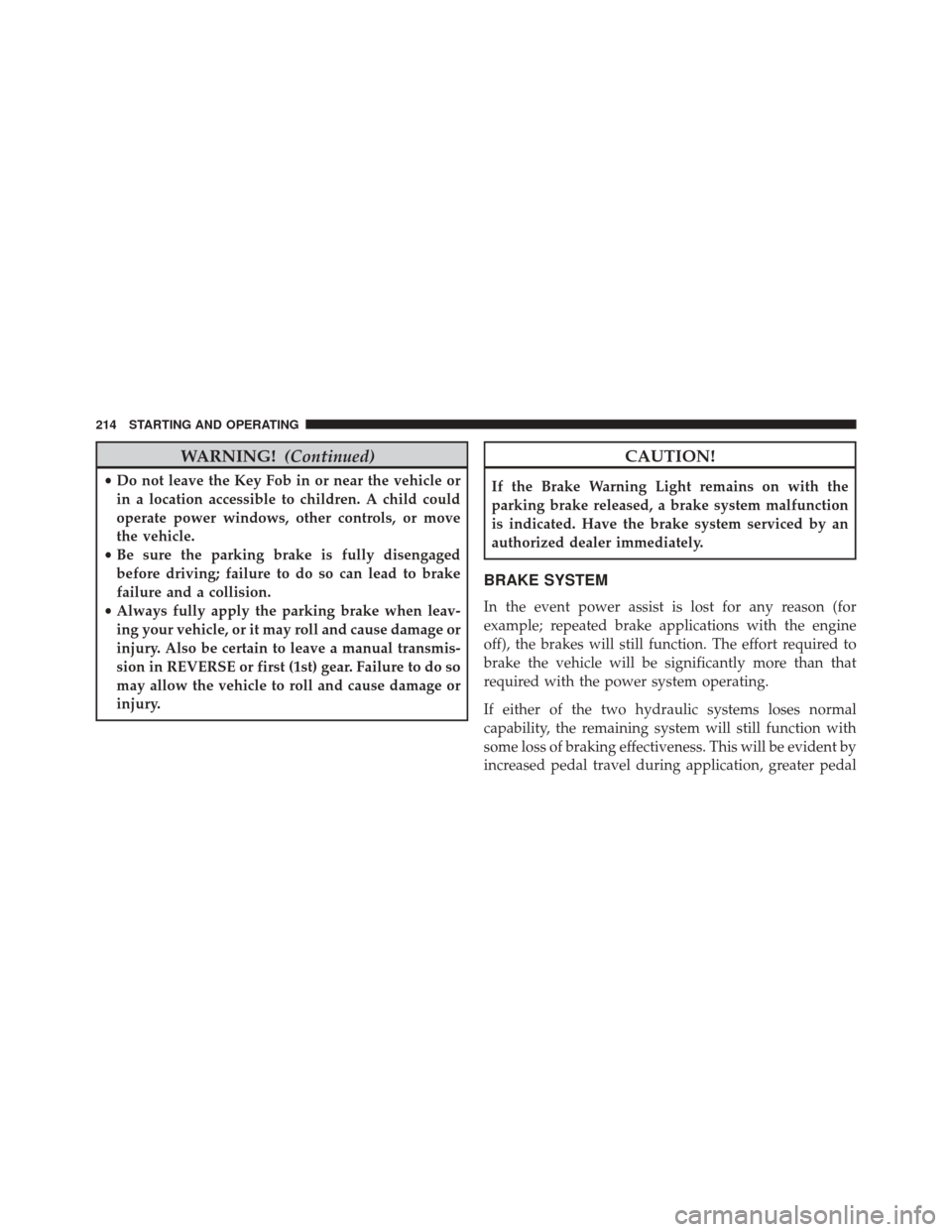
WARNING!(Continued)
•Do not leave the Key Fob in or near the vehicle or
in a location accessible to children. A child could
operate power windows, other controls, or move
the vehicle.
• Be sure the parking brake is fully disengaged
before driving; failure to do so can lead to brake
failure and a collision.
• Always fully apply the parking brake when leav-
ing your vehicle, or it may roll and cause damage or
injury. Also be certain to leave a manual transmis-
sion in REVERSE or first (1st) gear. Failure to do so
may allow the vehicle to roll and cause damage or
injury.
CAUTION!
If the Brake Warning Light remains on with the
parking brake released, a brake system malfunction
is indicated. Have the brake system serviced by an
authorized dealer immediately.
BRAKE SYSTEM
In the event power assist is lost for any reason (for
example; repeated brake applications with the engine
off), the brakes will still function. The effort required to
brake the vehicle will be significantly more than that
required with the power system operating.
If either of the two hydraulic systems loses normal
capability, the remaining system will still function with
some loss of braking effectiveness. This will be evident by
increased pedal travel during application, greater pedal
214 STARTING AND OPERATING
Page 255 of 410

Tire Pressure Monitoring Low Pressure Warnings
The Tire Pressure Monitoring Telltale Light will illumi-
nate in the instrument cluster, an audible chime will be
activated, and the “Check tire pressure” text message will
display when one or more of the four active road tire
pressures are low. Should this occur, you should stop as
soon as possible, check the inflation pressure of each tire
on your vehicle, and inflate each tire to the vehicle’s
recommended cold placard pressure value. The system
will automatically update and the Tire Pressure Monitor-
ing Light will extinguish once the updated tire pressures
have been received. The vehicle may need to be driven
for up to 20 minutes above 15 mph (24 km/h) to receive
this information.
Check TPMS Warnings
The Tire Pressure Monitoring Telltale Light will flash on
and off for 75 seconds and remain on solid when a system
fault is detected, an audible chime will be activated and
the “Tire Pressure Monitoring Unavailable” text message
will display. If the ignition key is cycled, this sequence
will repeat providing the system fault still exists. The Tire
Pressure Monitoring Telltale Light will turn off when the
fault condition no longer exists. A system fault can occur
with any of the following scenarios:
1. Jamming due to electronic devices or driving next tofacilities emitting the same radio frequencies as the
TPM sensors.
2. Installing some form of aftermarket window tinting that affects radio wave signals.
3. Snow or ice around the wheels or wheel housings.
5
STARTING AND OPERATING 253
Page 261 of 410
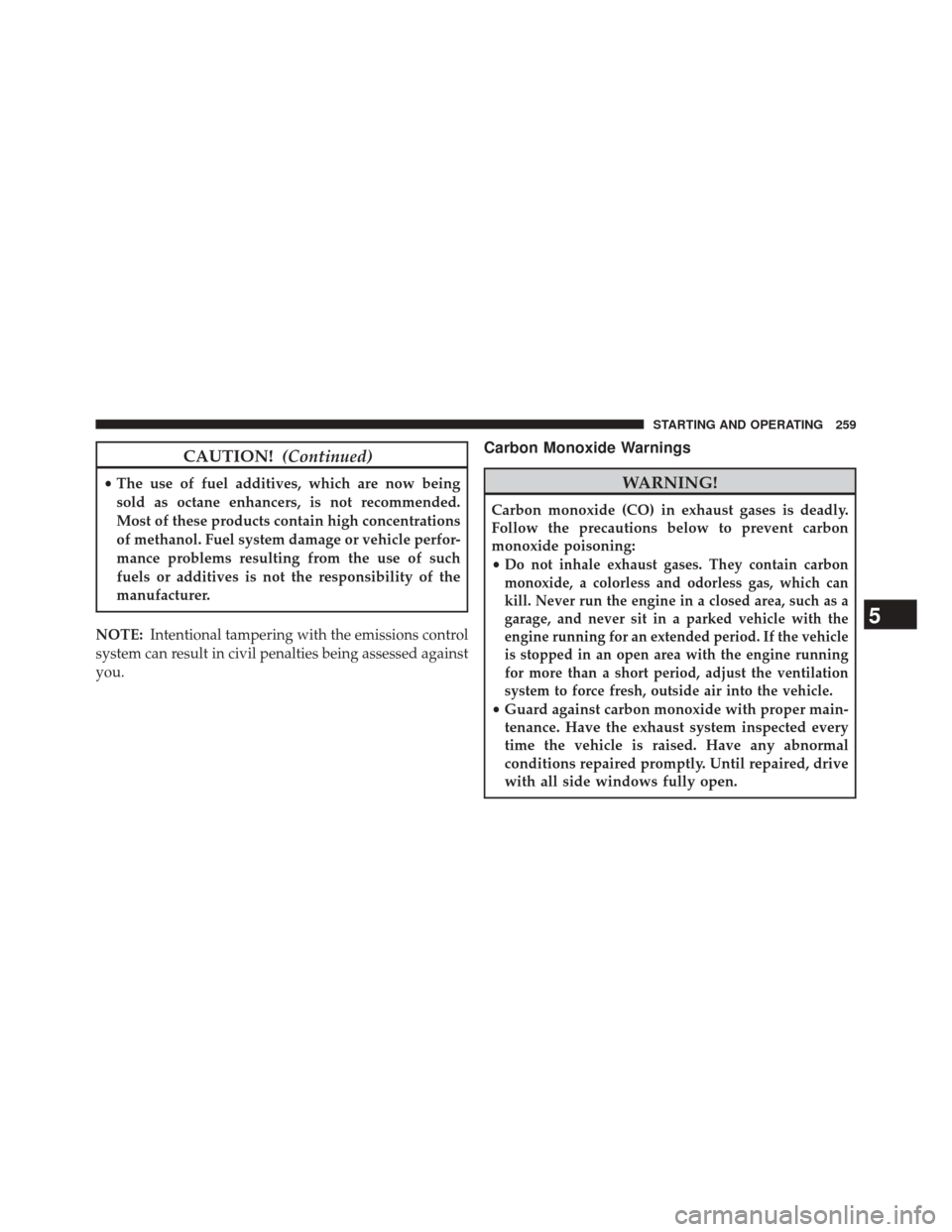
CAUTION!(Continued)
•The use of fuel additives, which are now being
sold as octane enhancers, is not recommended.
Most of these products contain high concentrations
of methanol. Fuel system damage or vehicle perfor-
mance problems resulting from the use of such
fuels or additives is not the responsibility of the
manufacturer.
NOTE: Intentional tampering with the emissions control
system can result in civil penalties being assessed against
you.
Carbon Monoxide Warnings
WARNING!
Carbon monoxide (CO) in exhaust gases is deadly.
Follow the precautions below to prevent carbon
monoxide poisoning:
•
Do not inhale exhaust gases. They contain carbon
monoxide, a colorless and odorless gas, which can
kill. Never run the engine in a closed area, such as a
garage, and never sit in a parked vehicle with the
engine running for an extended period. If the vehicle
is stopped in an open area with the engine running
for more than a short period, adjust the ventilation
system to force fresh, outside air into the vehicle.
• Guard against carbon monoxide with proper main-
tenance. Have the exhaust system inspected every
time the vehicle is raised. Have any abnormal
conditions repaired promptly. Until repaired, drive
with all side windows fully open.
5
STARTING AND OPERATING 259
Page 355 of 410

CAUTION!
•Do not use volatile solvents for cleaning purposes.
Many are potentially flammable, and if used in
closed areas they may cause respiratory harm.
• Do not use power washers to clean the inside of the
vehicle, plastic parts can be permanently damaged
and the amount of water can cause problems with
the electrical components of your vehicle.
Cleaning Headlights
Your vehicle is equipped with plastic headlights and fog
lights that are lighter and less susceptible to stone break-
age than glass headlights.
Plastic is not as scratch resistant as glass and therefore
different lens cleaning procedures must be followed. To minimize the possibility of scratching the lenses
and reducing light output, avoid wiping with a dry cloth.
To remove road dirt, wash with a mild soap solution
followed by rinsing.
Do not use abrasive cleaning components, solvents, steel
wool or other aggressive material to clean the lenses.
Glass Surfaces
All glass surfaces should be cleaned on a regular basis
with MOPAR® Glass Cleaner, or any commercial
household-type glass cleaner. Never use an abrasive type
cleaner. Use caution when cleaning the inside rear win-
dow equipped with electric defrosters or the right rear
quarter window equipped with the radio antenna. Do
not use scrapers or other sharp instrument that may
scratch the elements.
7
MAINTAINING YOUR VEHICLE 353
Page 365 of 410
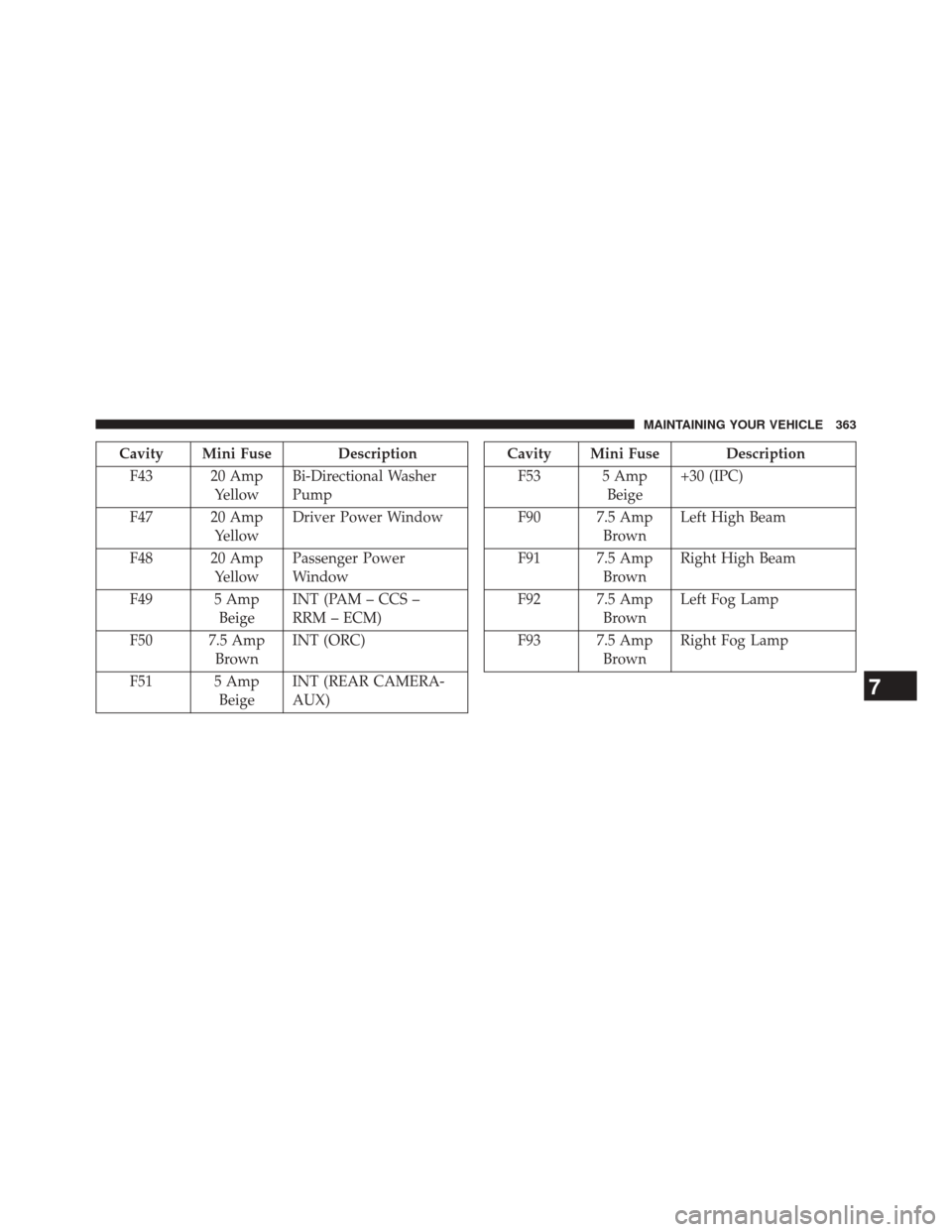
Cavity Mini Fuse DescriptionF43 20 Amp YellowBi-Directional Washer
Pump
F47 20 Amp YellowDriver Power Window
F48 20 Amp YellowPassenger Power
Window
F49 5 Amp BeigeINT (PAM – CCS –
RRM – ECM)
F50 7.5 Amp BrownINT (ORC)
F51 5 Amp BeigeINT (REAR CAMERA-
AUX)Cavity Mini Fuse Description
F53 5 Amp Beige+30 (IPC)
F90 7.5 Amp BrownLeft High Beam
F91 7.5 Amp BrownRight High Beam
F92 7.5 Amp BrownLeft Fog Lamp
F93 7.5 Amp BrownRight Fog Lamp
7
MAINTAINING YOUR VEHICLE 363
Page 366 of 410
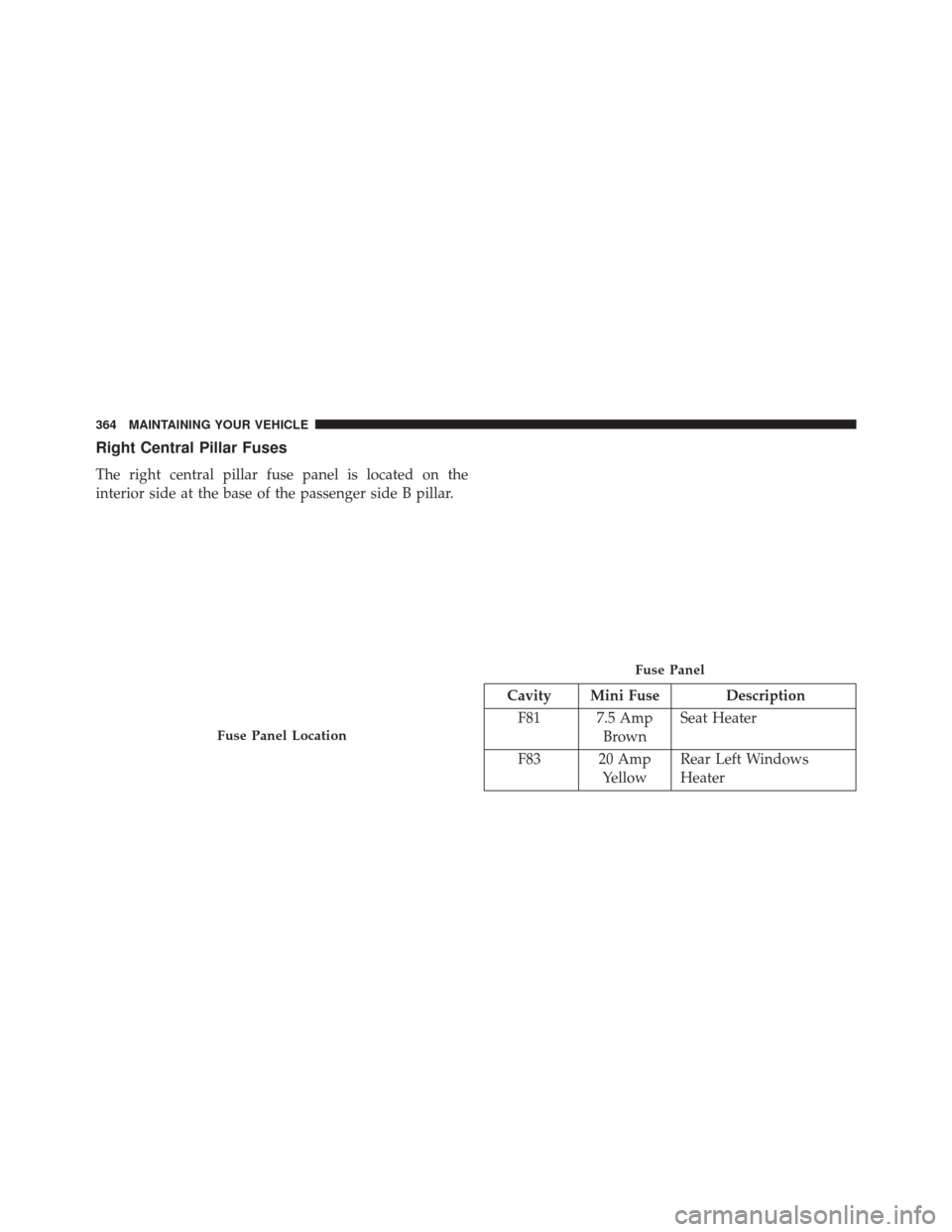
Right Central Pillar Fuses
The right central pillar fuse panel is located on the
interior side at the base of the passenger side B pillar.
Cavity Mini Fuse DescriptionF81 7.5 Amp BrownSeat Heater
F83 20 Amp YellowRear Left Windows
Heater
Fuse Panel Location
Fuse Panel
364 MAINTAINING YOUR VEHICLE
Page 367 of 410

Cavity Mini Fuse DescriptionF84 20 Amp YellowRear Right Windows
Heater
F85 10 Amp RedRear Heater Prep
VEHICLE STORAGE
If you are leaving your vehicle dormant for more than 21
days, you may want to take these steps to protect your
battery.
•
Disconnect the negative cable from the battery.
• Anytime you store your vehicle, or keep it out of
service (e.g., vacation) for two weeks or more, run the
air conditioning system at idle for about five minutes
in the fresh air and high blower setting. This will
ensure adequate system lubrication to minimize the
possibility of compressor damage when the system is
started again.
REPLACEMENT BULBS
Interior Bulbs
Bulb Number
Overhead Lamp C5W
Sun Visors C5W
Courtesy Lamp FF500
Glove Compartment C5W
Rear Courtesy Lamp C5W
Exterior Bulbs
Bulb Number
Front Low and High Beam
Headlamp H7LL
Front Park/Turn Signal Lamps 7444NA
Daytime Running Lamps
(if equipped) 74407
MAINTAINING YOUR VEHICLE 365
Page 394 of 410
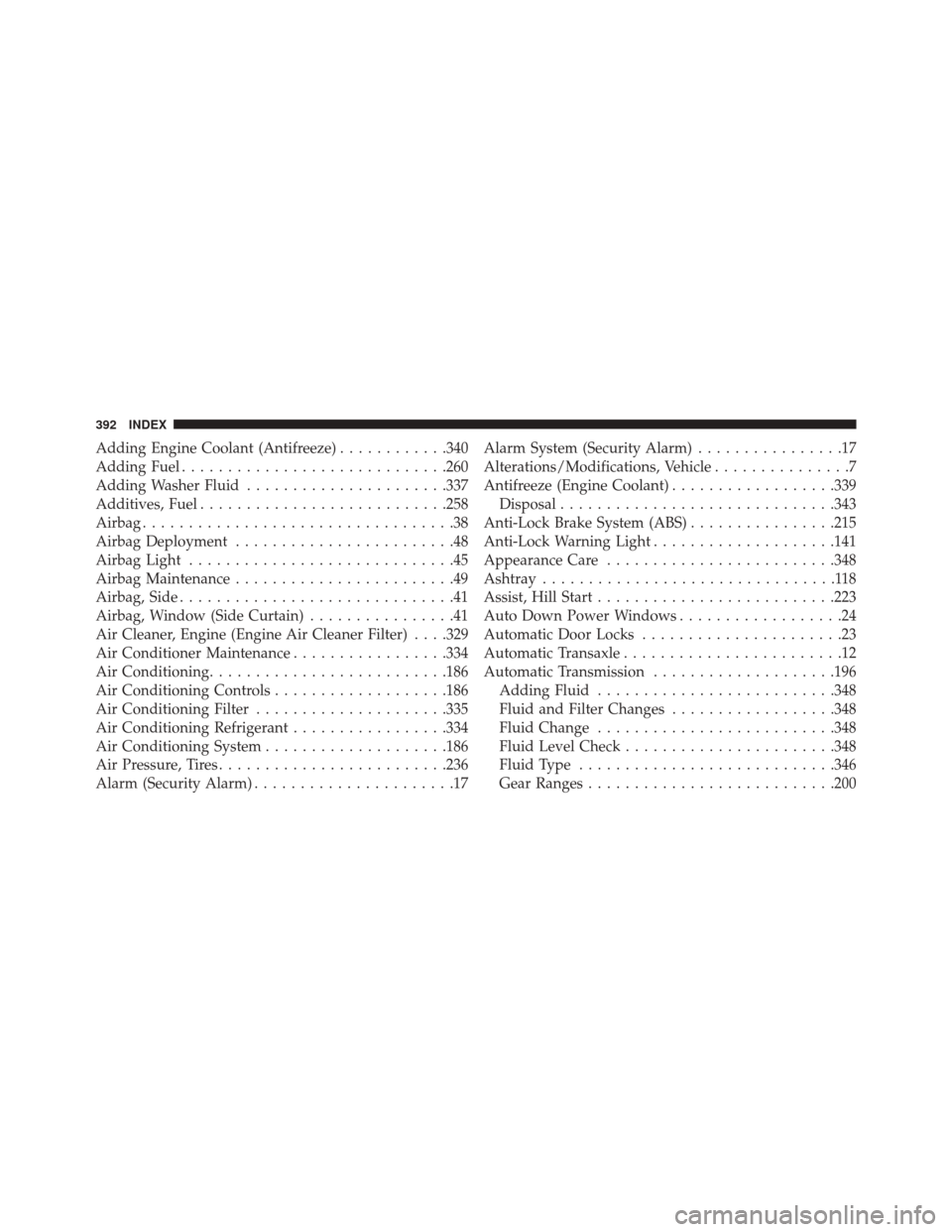
Adding Engine Coolant (Antifreeze)............340
Adding Fuel ............................ .260
Adding Washer Fluid ..................... .337
Additives, Fuel .......................... .258
Airbag ..................................38
Airbag Deployment ........................48
Airbag Light .............................45
Airbag Maintenance ........................49
Airbag, Side ..............................41
Airbag, Window (Side Curtain) ................41
Air Cleaner, Engine (Engine Air Cleaner Filter) . . . .329
Air Conditioner Maintenance .................334
Air Conditioning ......................... .186
Air Conditioning Controls ...................186
Air Conditioning Filter .....................335
Air Conditioning Refrigerant .................334
Air Conditioning System ....................186
Air Pressure, Tires ........................ .236
Alarm (Security Alarm) ......................17 Alarm System (Security Alarm)
................17
Alterations/Modifications, Vehicle ...............7
Antifreeze (Engine Coolant) ..................339
Disposal ............................. .343
Anti-Lock Brake System (ABS) ................215
Anti-Lock Warning Light ....................141
Appearance Care ........................ .348
Ashtray ................................118
Assist, Hill Start ......................... .223
Auto Down Power Windows ..................24
Automatic Door Locks ......................23
Automatic Transaxle ........................12
Automatic Transmission ....................196
Adding Fluid ......................... .348
Fluid and Filter Changes ..................348
Fluid Change ......................... .348
Fluid Level Check ...................... .348
Fluid Type ........................... .346
Gear Ranges .......................... .200
392 INDEX
Page 403 of 410
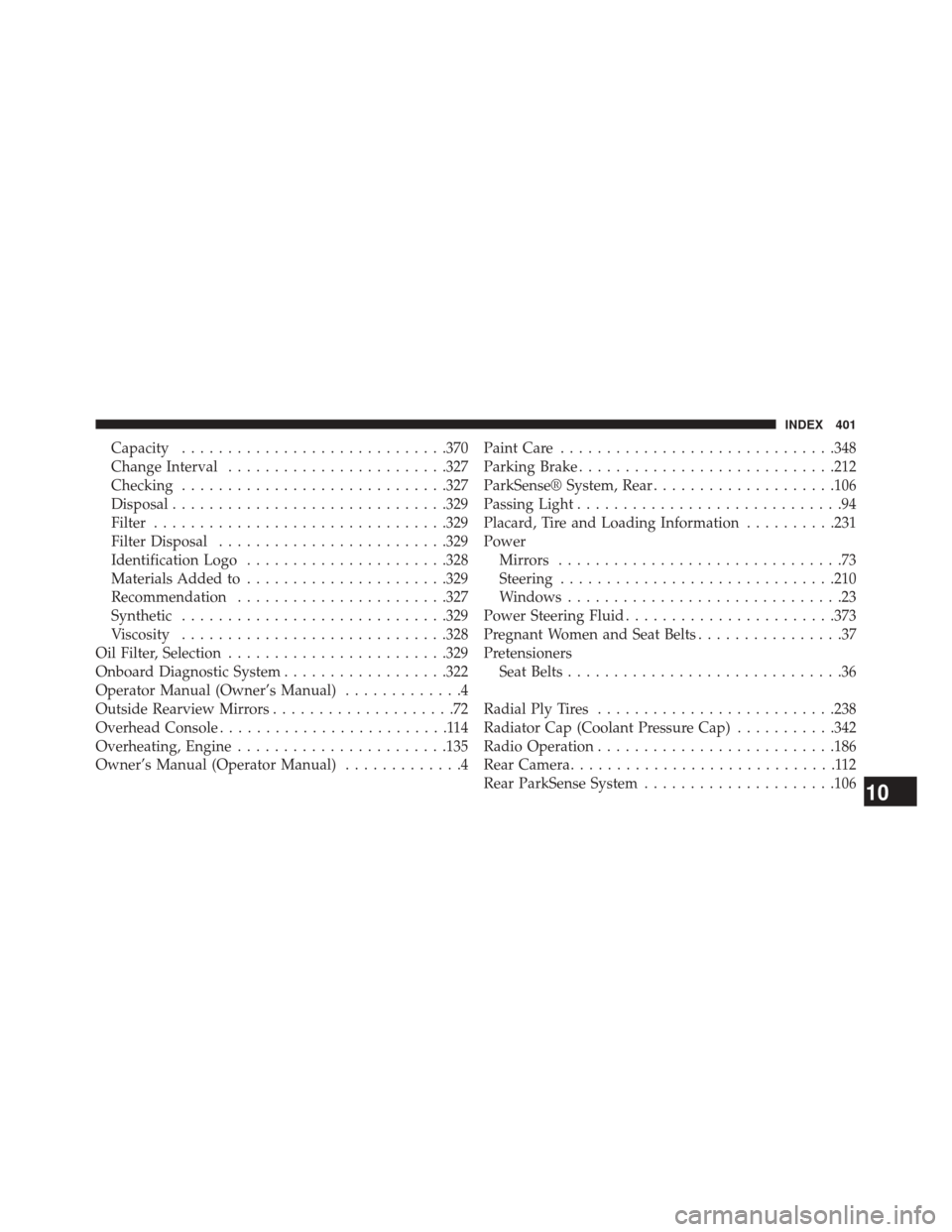
Capacity............................ .370
Change Interval ....................... .327
Checking ............................ .327
Disposal ............................. .329
Filter ............................... .329
Filter Disposal ........................ .329
Identification Logo ..................... .328
Materials Added to ..................... .329
Recommendation ...................... .327
Synthetic ............................ .329
Viscosity ............................ .328
Oil Filter, Selection ....................... .329
Onboard Diagnostic System ..................322
Operator Manual (Owner’s Manual) .............4
Outside Rearview Mirrors ....................72
Overhead Console .........................114
Overheating, Engine ...................... .135
Owner’s Manual (Operator Manual) .............4Paint Care
............................. .348
Parking Brake ........................... .212
ParkSense® System, Rear ....................106
Passing Light .............................94
Placard, Tire and Loading Information ..........231
Power Mirrors ...............................73
Steering ............................. .210
Windows ..............................23
Power Steering Fluid ...................... .373
Pregnant Women and Seat Belts ................37
Pretensioners Seat Belts ..............................36
Radial Ply Tires ......................... .238
Radiator Cap (Coolant Pressure Cap) ...........342
Radio Operation ......................... .186
Rear Camera .............................112
Rear ParkSense System .....................106
10
INDEX 401